Home Health or Personal Care Aide
Does this career fit your work personality?
Begin The Career Assessment Test- Best Fitting Careers
- Work Personality Strengths
- Work Style Preferences
- and more
What Home Health and Personal Care Aides Do
Home health and personal care aides monitor the condition of people with disabilities or chronic illnesses and help them with daily living activities. They often help older adults who need assistance. Under the direction of a nurse or other healthcare practitioner, home health aides may be allowed to give a client medication or to check the client’s vital signs.
Duties
Home health and personal care aides typically do the following:
- Assist clients in their daily personal tasks, such as bathing or dressing
- Perform housekeeping tasks, such as laundry, washing dishes, and vacuuming
- Help to organize a client’s schedule and plan appointments
- Arrange transportation to doctors’ offices or other outings
- Shop for groceries and prepare meals to meet a client’s dietary specifications
- Keep clients engaged in their social networks and communities
Home health aides may provide some basic health-related services—such as checking a client’s pulse, temperature, and respiration rate—depending on the state in which they work. They also may help with simple prescribed exercises and with giving medications. Occasionally, they change bandages or dressings, give massages, care for skin, or help with braces and artificial limbs. With special training, experienced home health aides also may help with medical equipment, such as ventilators to help clients breathe.
Home health aides are supervised by medical practitioners, usually nurses, and may work with therapists and other medical staff. These aides keep records on the client, such as services received, condition, and progress. They report changes in the client’s condition to a supervisor or case manager.
Personal care aides, sometimes called caregivers or personal attendants, are generally limited to providing nonmedical services, including companionship, cleaning, cooking, and driving. Some of these aides work specifically with people who have developmental or intellectual disabilities to help create a behavior plan and teach self-care skills, such as doing laundry or cooking meals.
Work Environment

Home health and personal care aides held about 3.7 million jobs in 2022. The largest employers of home health and personal care aides were as follows:
| Individual and family services | 49% |
| Home healthcare services | 24 |
| Residential intellectual and developmental disability facilities | 7 |
| Continuing care retirement communities and assisted living facilities for the elderly | 7 |
Many home health and personal care aides work in clients’ homes; others work in group homes or care communities. Some aides work with only one client, while others work with groups of clients. They sometimes stay with one client on a long-term basis or for a specific purpose, such as hospice care. They may work with other aides in shifts so that the client always has an aide.
Aides may travel as they help people with disabilities go to work and stay engaged in their communities.
Injuries and Illnesses
Work as a home health or personal care aide can be physically and emotionally demanding. Because they often move clients into and out of bed or help with standing or walking, aides must use proper lifting techniques to guard against back injury.
In addition, aides may work with clients who have cognitive impairments or mental health issues and who may display difficult or violent behaviors. Aides also face hazards from minor infections and exposure to communicable diseases but can lessen their chance of infection by following proper procedures.
Work Schedules
Most aides work full time, although part-time work is common. They may work evening and weekend hours, depending on their clients’ needs. Work schedules may vary.
Getting Started
How to Become a Home Health or Personal Care Aide

Home health and personal care aides typically need a high school diploma or equivalent, but some positions do not require it. Those working in certified home health or hospice agencies must complete formal training and pass a standardized test.
Education
Home health and personal care aides typically need a high school diploma or equivalent, although some positions do not require a formal educational credential. Postsecondary nondegree award programs are available at community colleges and vocational schools.
Training
Home health and personal care aides may be trained in housekeeping tasks, such as cooking for clients who have special dietary needs. Aides may learn basic safety techniques, including how to respond in an emergency. If state certification is required, specific training may be needed.
Training may be completed on the job or through programs. Training typically includes learning about personal hygiene, reading and recording vital signs, infection control, and basic nutrition.
In addition, individual clients may have preferences that aides need time to learn.
Licenses, Certifications, and Registrations
Home health and personal care aides may need to meet requirements specific to the state in which they work. For example, some states require home health aides to have a license or certification, which may involve completing training and passing a background check and a competency exam. For more information, check with your state board of health.
Certified home health or hospice agencies that receive payments from federally funded programs, such as Medicare, must comply with regulations regarding aides’ employment. Private care agencies that do not receive federal funds may have other employment requirements that vary by state.
Aides also may be required to obtain certification in first aid and cardiopulmonary resuscitation (CPR).
Job Outlook
Employment of home health and personal care aides is projected to grow 22 percent from 2022 to 2032, much faster than the average for all occupations.
About 684,600 openings for home health and personal care aides are projected each year, on average, over the decade. Many of those openings are expected to result from the need to replace workers who transfer to different occupations or exit the labor force, such as to retire.
Employment
The services that home health and personal care aides provide will be in high demand to care for the rising number of older people.
The locations in which care is offered are affected by both policy changes and lifestyle preferences of older adults and people with disabilities. Long-term care services are increasingly shifting from institutional settings, such as nursing homes, to home- and community-based settings. This shift is expected to create many new jobs for home health and personal care aides.
Contacts for More Information
For more information about home health and personal care aides, visit
National Association for Home Care & Hospice
For more information about licensing and certification requirements, check with your state board of health.
Similar Occupations
This table shows a list of occupations with job duties that are similar to those of home health and personal care aides.
| Occupation | Job Duties | Entry-Level Education | Median Annual Pay, May 2022 | |
|---|---|---|---|---|

|
Childcare Workers |
Childcare workers attend to children's needs while helping to foster early development. |
High school diploma or equivalent | $28,520 |

|
Licensed Practical and Licensed Vocational Nurses |
Licensed practical nurses (LPNs) and licensed vocational nurses (LVNs) provide basic medical care. |
Postsecondary nondegree award | $54,620 |

|
Medical Assistants |
Medical assistants complete administrative and clinical tasks, such as scheduling appointments and taking patients’ vital signs. |
Postsecondary nondegree award | $38,270 |

|
Nursing Assistants and Orderlies |
Nursing assistants provide basic care and help patients with activities of daily living. Orderlies transport patients and clean treatment areas. |
See How to Become One | $35,740 |

|
Occupational Therapy Assistants and Aides |
Occupational therapy assistants and aides help patients develop, recover, improve, as well as maintain the skills needed for daily living and working. |
See How to Become One | $63,450 |

|
Physical Therapist Assistants and Aides |
Physical therapist assistants and aides are supervised by physical therapists to help patients regain movement and manage pain after injuries and illnesses. |
See How to Become One | $57,240 |

|
Psychiatric Technicians and Aides |
Psychiatric technicians and aides care for people who have mental conditions or developmental disabilities. |
See How to Become One | $37,330 |

|
Registered Nurses |
Registered nurses (RNs) provide and coordinate patient care and educate patients and the public about various health conditions. |
Bachelor's degree | $81,220 |

|
Social and Human Service Assistants |
Social and human service assistants provide client services in a variety of fields, such as psychology, rehabilitation, and social work. |
High school diploma or equivalent | $38,520 |
